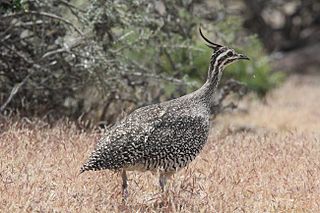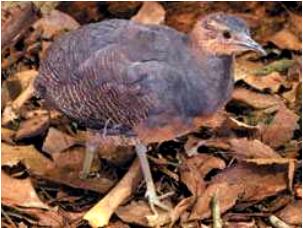
Tinamous are members of the order Tinamiformes, and family Tinamidae, divided into two distinct subfamilies, containing 46 species found in Mexico, Central America, and South America. The word "tinamou" comes from the Galibi term for these birds, tinamu. Tinamous are the only living group of palaeognaths able to fly, and were traditionally regarded as the sister group of the flightless ratites, but recent work places them well within the ratite radiation as most closely related to the extinct moa of New Zealand, implying flightlessness emerged among ratites multiple times. Tinamous first appear in the fossil record in the Miocene epoch. They are generally sedentary, ground-dwelling and, though not flightless, when possible avoid flight in favour of hiding or running away from danger. They are found in a variety of habitats, ranging from semi-arid alpine grasslands to tropical rainforests. The two subfamilies are broadly divided by habitat, with the Nothurinae referred to as steppe or open country tinamous, and the Tinaminae known as forest tinamous.
The Magdalena tinamou, Crypturellus erythropus saltuarius, is a member of one of the most ancient bird families, the tinamous. It is endemic to the Magdalena River Valley in Colombia, and had been considered possibly extinct, because of an absence of confirmed records since the type specimen was collected in 1943. The most recent review consider it likely that it is extant, as locals have reported sightings in the 1970s and 1980s, an individual was apparently held in captivity until the early 1990s, and a few patches of forest remain in its presumed range. Additionally, a record was made in late 2008. It was rediscovered in 2023.

The brown tinamou is a brownish ground bird found in humid lowland and montane forest in tropical and subtropical South America.

The yellow-legged tinamou is a species of tinamou found in wooded and shrubby habitats in tropical and subtropical eastern Brazil. This superficially quail-like bird has a grey-brown plumage and two easily separated subspecies. It has declined due to human activities, and is therefore listed as Near Threatened by the IUCN.

Hapalops is an extinct genus of ground sloth from the Early to Late Miocene of Brazil, Bolivia, Colombia, and Argentina in South America.

Crypturellus is a genus of tinamous containing mostly forest species. However, there are the odd few that are grassland or steppe tinamous. The genus contains 21 species.

The undulated tinamou is a species of ground bird found in a wide range of wooded habitats in eastern and northern South America.

The pale-browed tinamou is a type of tinamou found in tropical dry forests in Peru and Ecuador.
The Colombian tinamou, Crypturellus erythropus columbianus, is a tinamou found in Córdoba, Sucre, Bolívar, and Antioquia in north-central Colombia. Little is known about it. It occurs in lowland moist forest and shrubland at elevation up to 600 m (2,000 ft).

The thicket tinamou or rufescent tinamou is a type of tinamou commonly found in moist forests in subtropical and tropical central Mexico.

The slaty-breasted tinamou or Boucard's tinamou is a type of tinamou commonly found in lowland moist forests of Mexico and Central America.

The small-billed tinamou is a type of Tinamou commonly found in dry savanna in Amazonian South America.

The Tataupa tinamou is a type of tinamou commonly found in dry forest in subtropical and tropical regions in southeastern South America.

The Chilean tinamou is a type of tinamou commonly found in high elevation shrubland in subtropical regions of central Chile.

The brushland tinamou is a type of tinamou commonly found in high-altitude dry shrubland in subtropical and tropical regions of southern South America.
Opisthodactylus is an extinct genus of rheiform bird from the Early to Middle Miocene Santa Cruz and Chichinales Formations and the Late Miocene (Montehermosan) Andalhuala Formation of Argentina. Three species are described: the type species, O. patagonicus, O. kirchneri and O. horacioperezi. The species O. kirchneri was described in 2017 by Noriega et al. Fossils of O. horacioperezi were found together with fossils of Patagorhacos terrificus.

Patagornis is a genus of extinct flightless predatory birds of the family Phorusrhacidae. Known as "terror birds", these lived in what is now Argentina during the Early and Middle Miocene; the Santa Cruz Formation in Patagonia contains numerous specimens. Patagornis was an agile, medium sized Patagornithine and was likely a pursuit predator.

Psilopterus is an extinct genus of phorusrhacid from the Middle Oligocene to possibly the Late Pleistocene of Argentina and Uruguay. Compared to other phorusrhacids, members of the genus are both relatively gracile and diminutive, and include the smallest known species of terror bird: with the head raised P. bachmanni was 70–80 centimeters (2.3–2.6 ft) in height and weighed about 5 kilograms (11 lb), while the largest members of the genus were only about 8 kilograms (18 lb). The birds resemble the modern cariama, except with a heavier build and considerably smaller wings. Fossil finds in Uruguay indicate the genus may have survived until 96,040 ± 6,300 years ago, millions of years after the larger phorusrhacids became extinct.

Tinaminae, the forest tinamous, is one of two subfamilies of the family Tinamidae, the other being Nothurinae.













